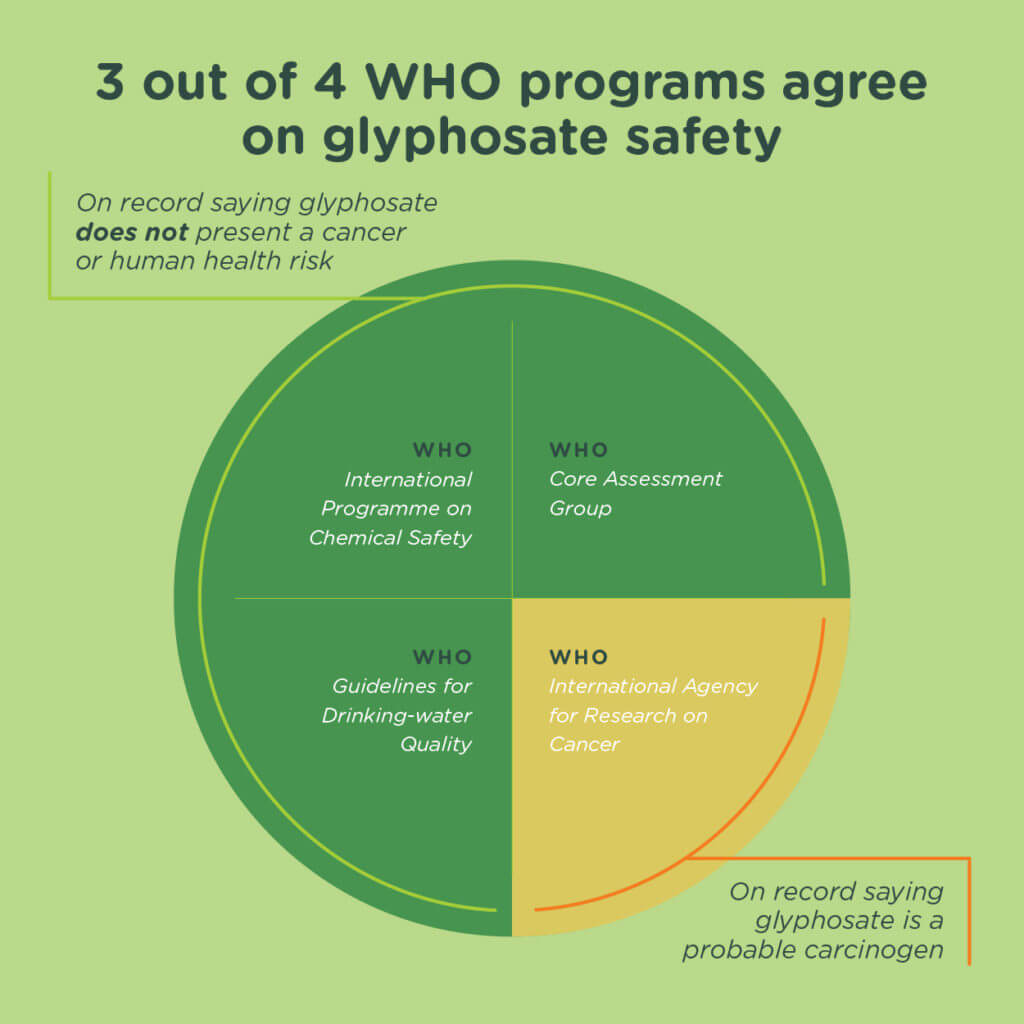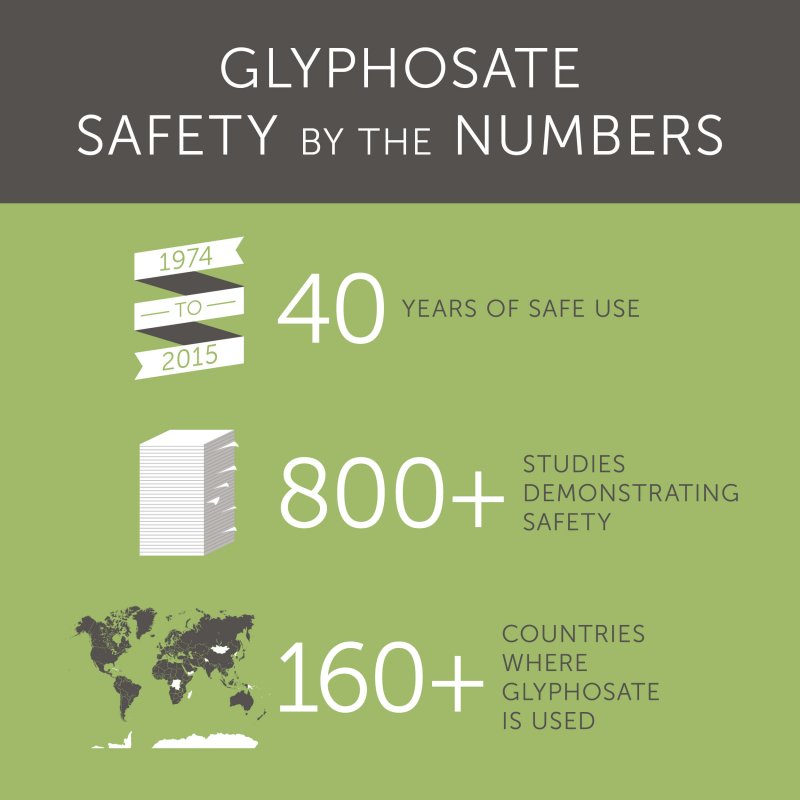It’s either the darling of GMO-loving Big Ag or the demon imperiling small-farmers and organic growers worldwide (or both!). It’s glyphosate (formerly patented and branded as Roundup), and it’s the most widely used pesticide in the world. Although it was introduced in 1974, more than 20 years before the introduction of GMOs, much of its increased use is because it can kill weeds without killing crops that have been genetically modified to resist glyphosate.
But what is it, really? And is it dangerous?
Most famously, this year the International Agency for Research on Cancer (IARC), an arm of the World Health Organization that evaluates the hazards (but not risks — a key distinction) of all sorts of everyday activities and products, declared that glyphosate was a Class 2a hazard, putting it in the “probably carcinogenic to humans” along with 73 other things including high temperature frying and excessive sunlight. Meanwhile, the U.S. EPA, the European Commission and other health and environmental agencies have declared it safe as used, and it’s licensed for use in 130 countries.
We’ve talked about risks, hazards and words like “probably” in other articles. Here, we’ll review what scientists have really found about glyphosate.
IARC’s full report available
IARC’s full monograph with scientific studies and references is now available, and will no doubt provide more information (or fodder) on how dangerous glyphosate may be. We won’t go over the monograph in detail in this article, but we can review a few human exposure claims to look at some issues. For human exposure, IARC cited two Ecuadoran studies:
- The first reported statistically significant DNA damage among people who lived less than 3 kilometers from sites where the Ecuadorian government had used glyphosate formulations to kill off illegal coca plants. These were people who had exhibited symptoms of acute toxicity.
- However, the same group studied individuals who lived in northern Ecuador 2 years after the last government spraying occurred, and found normal karyotypes compared to control groups.
- Other human exposure studies in Colombia found increased incidences of micronucleus formation (a marker indicating chromosomal damage) in women agricultural workers living in areas that had received glyphosate spraying.
- They did not, however, find cancer.
Andrew Kniss, plant scientist at the University of Wyoming, earlier discussed other studies that were cited in IARC’s paper in Lancet (announcing its 2a classification).
Weak cancer link
The IARC study’s main (some say only) cancer link to glyphosate is non-Hodgkin lymphoma, a cancer affecting white blood cells (more on NHL below). However, Kniss pointed out that only three studies on NHL were cited in IARC’s Lancet paper. Those studies showed that, using a 95 percent confidence interval (a statistical tool that determines how a study’s data “spreads” across the criteria its studying), there appeared to be some valid link between glyphosate and NHL. However, two of the three had data within a 95 percent confidence interval that showed no–or even a slightly negative relationship between the pesticide and cancer, meaning that based on incomplete data glyphosate could actually insulate someone exposed to cancer.
These three studies were “case control studies,” which Kniss described as a:
Type of study (that) takes a large number of ‘cases’ of the disease of interest, finds a similar group of people without the disease, and then tries to find differences in risk factors between the groups. Any factors that are more prevalent in the ‘case’ group (the group with the disease) are viewed as possible risk factors for the disease.
Kniss also pointed out that in the case control studies, very few people with NHL were actually exposed to glyphosate. Case control studies do have a limitation, in which they cannot control other variables very well. In this case, people exposed to glyphosate are probably also exposed to other pesticides. And that’s hard to rule out.
Another type of study, called a cohort study, follows people for some time (it varies among studies) and records risk factors and the research participants’ health outcomes. In a cohort study cited in IARC’s Lancet paper, Kniss notes a very different result.
These results suggest there is no discernible link between glyphosate and non-Hodgkin lymphoma among a population where glyphosate use is the most common. Over 41,000 of the 54,315 study participants had been exposed to glyphosate in this study. And 99.82% of them did not get non-Hodgkin lymphoma during the course of the study.
Scientists respond
Many scientists around the world have responded to the IARC report and other studies on glyphosate. Val Giddings, senior fellow at The Information and Technologies Innovation Center, pointed out before IARC released its full report that several studies were missing, and other studies, like the infamous retracted Seralini rat study, were included. The Seralini study is referenced in the full report, but the IARC Working Group rather politely but definitively noted the significant inadequacies of that study.
In his response to the findings and studies cited by IARC, Sir Colin Berry, Emeritus Professor of Pathology at Queen Mary University of London, said:
There are over 60 genotoxicity studies on glyphosate with none showing results that should cause alarm relating to any likely human exposure. For human epidemiological studies there are seven cohort and 14 case control studies, none of which support carcinogenicity.
The authors have included non-Hodgkin lymphoma (NHL), but that diagnosis is no longer used in pathology because it’s far too imprecise. Even if you do include NHL there are still 7 studies, only one of which is positive – and that one is not a good study in my view.
Berry has a point about NHL. There are, in fact, many kinds of cancers that fall under the category of “non-Hodgkin lymphoma.” The American Cancer Society lists more than 25 types and subtypes of NHL, and that doesn’t include the rare versions. Thus, since these lymphomas have no known cause (anti-glyphosate rhetoric to the contrary), studies looking at links between environmental exposure of anything and lymphoma would need to determine the exact type of lymphoma being examined.
Rounding up cancer — maybe
Glyphosate was first synthesized as a pharmaceutical drug candidate in 1950 — its herbicidal properties were not discovered for another 20 years. There are also intriguing hints that glyphosate might have medicinal properties, in particular it may actually lead to better treatments for cancer. The consumer products company Procter and Gamble filed for a patent in 1995 on glyphosate as an anti-cancer treatment. Much more recently, a research group from Tulane University in New Orleans and from China found that glyphosate and its degradation product, a compound called AMDA, halted growth of eight human cancer cell lines (while leaving two normal cell lines alone).
So, is glyphosate safe? Considering it’s many properties, that’s a narrow way to frame this issue. Yes, it can act as a pesticide, so don’t drink it. But it’s much safer that other pesticides that have been used (including some organic ones, like copper sulfate or rotenone), and its harm to humans seems limited to acute or prolonged high exposure among agricultural workers. In fact, it may directly or indirectly lead to new drugs for cancer. The anti-GMO activist community might have picked a scarier bogeyman.
Andrew Porterfield is a writer, editor and communications consultant for academic institutions, companies and non-profits in the life sciences. He is based in Camarillo, California. Follow @AMPorterfield on Twitter.































